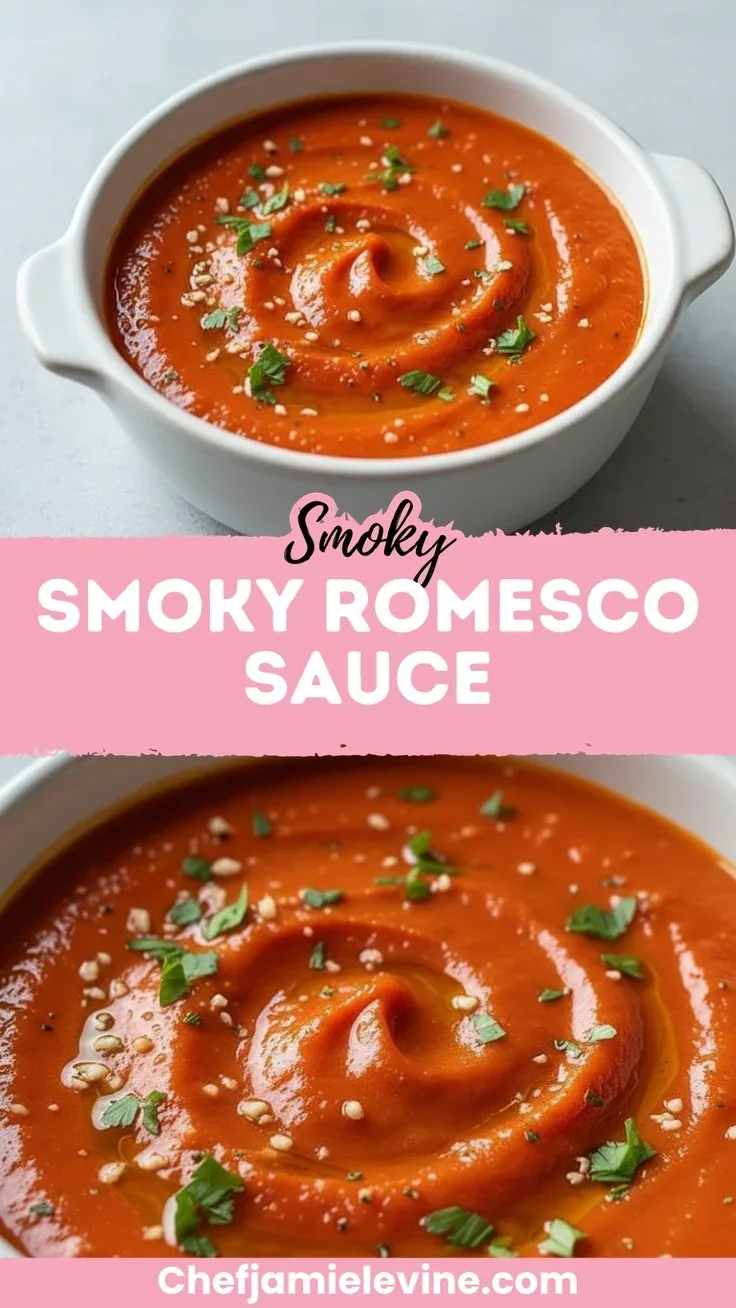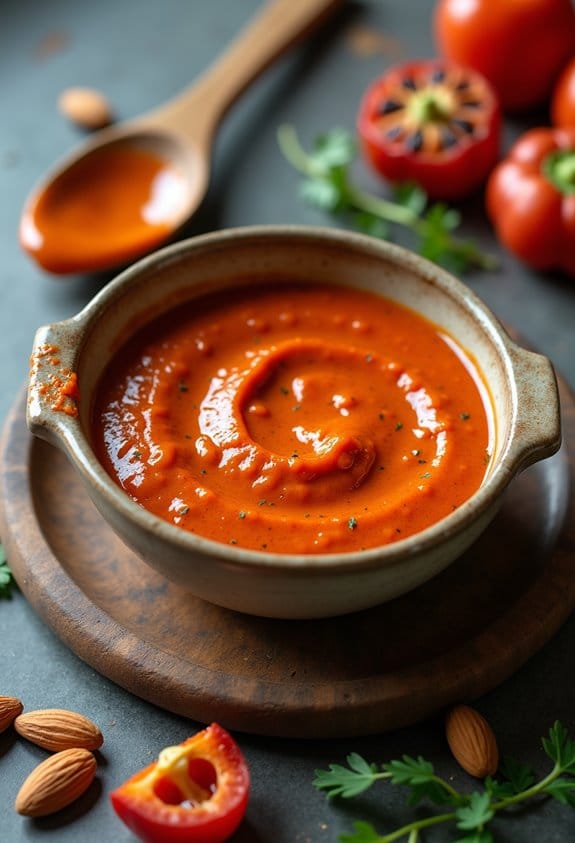Why You’ll Love this Smoky Romesco Sauce
This sauce, a Spanish treasure with deep Catalonian roots, will transform your kitchen into a Mediterranean escape with just a food processor and a handful of pantry staples.
I’m obsessed with its versatility—creamy yet textured, smoky yet bright. The roasted peppers deliver sweet depth while smoked paprika adds that characteristic Spanish warmth.
Ever wondered what to do with those jarred roasted peppers? This is it.
The best part? You can adjust the thickness to suit your needs—chunky for dipping, silky for drizzling.
And talk about make-ahead friendly. Whip up a batch Sunday, enjoy it all week on everything from eggs to vegetables.
What Ingredients are in Smoky Romesco Sauce?
Romesco sauce is all about balancing bold flavors with a creamy, versatile texture. The beauty of this Spanish classic lies in its simple ingredients that, when combined, create something truly magical.
Each component plays a significant role—the roasted peppers provide sweetness, the almonds add body, and the paprika brings that characteristic smokiness that makes this sauce so addictive.
Ingredients:
- 1 large roasted red bell pepper, peeled and seeded (jarred is fine, just pat dry)
- 1 medium roasted tomato, peeled (or ½ cup canned fire-roasted tomatoes, drained)
- ½ cup toasted almonds (or hazelnuts)
- 1 garlic clove
- 1 tablespoon sherry vinegar (or red wine vinegar)
- ½ teaspoon smoked paprika (pimentón)
- ¼ teaspoon fine salt, plus more to taste
- 3 tablespoons olive oil, plus more as needed
- Optional: pinch of red pepper flakes
- Optional: 1-2 tablespoons torn day-old bread for extra body
Don’t worry too much about having exactly the right ingredients—romesco is wonderfully flexible.
Need to make it nut-free? Swap in toasted sunflower seeds.
Can’t find sherry vinegar? Red wine vinegar works beautifully.
The key is getting that balance of smoky, sweet, and tangy just right.
And if you’re short on time, the shortcut version using jarred roasted peppers and canned fire-roasted tomatoes delivers nearly identical results with half the effort.
Just remember to drain them well and pat dry to maintain that luxurious thickness we’re after.
How to Make this Smoky Romesco Sauce

Making romesco sauce is surprisingly simple, and the process rewards you with layers of flavor that develop as you go.
Start by chopping your base ingredients – add ½ cup toasted almonds and 1 garlic clove to your food processor or blender and pulse until they’re finely ground. This creates the foundation of texture that makes romesco so satisfying. The nuts provide that signature body while the garlic lays down the aromatic backbone.
Next comes the blending stage, where everything really starts to come together. Add 1 large roasted red bell pepper (patted dry if using jarred), 1 medium roasted tomato (or those convenient fire-roasted canned tomatoes), 1 tablespoon of sherry vinegar, ½ teaspoon of smoked paprika, and ¼ teaspoon fine salt to your processor. If you’re looking for extra body, this is when you’d toss in 1-2 tablespoons of torn day-old bread.
Blend until mostly smooth, pausing occasionally to scrape down the sides. The mixture should be starting to look vibrant and smell incredible at this point.
The final step is where the magic happens – emulsification. With your food processor or blender running, slowly stream in 3 tablespoons of olive oil until the sauce becomes thick and spoonable. This gradual addition creates that silky texture that’s neither too runny nor too stiff.
Take a moment to check the consistency; it should hold soft swirls when moved with a spoon. Need adjustments? A splash of warm water will loosen it if it’s too thick, or a bit more oil adds extra silkiness.
Before serving, taste and tweak with additional salt or vinegar to brighten the flavor, or add a pinch of red pepper flakes if you’re craving heat. The finished sauce is best served at room temperature, where all those complex flavors can truly shine.
Smoky Romesco Sauce Substitutions and Variations
While traditional Spanish romesco sauce has deep roots in Catalonian cuisine, I’ve discovered it’s one of the most adaptable condiments in my kitchen arsenal.
Need it nut-free? Swap in toasted sunflower seeds. No sherry vinegar? Red wine vinegar works beautifully.
For an even smokier version, char your peppers and tomatoes under the broiler and add an extra dash of smoked paprika.
The sauce responds well to herbs, too—a handful of parsley pulsed in at the end adds bright freshness.
My favorite twist? Using hazelnuts instead of almonds for a slightly deeper, woodsier flavor profile that pairs wonderfully with grilled fish.
What to Serve with Smoky Romesco Sauce
The versatility of this vibrant sauce extends far beyond its ingredient list.
I love pairing romesco with grilled vegetables—zucchini and bell peppers become magical with a generous smear. It transforms roasted potatoes from simple side to showstopper, and turns ordinary protein into restaurant-worthy fare (especially seafood like shrimp or salmon).
Don’t overlook romesco as a sandwich spread, where it replaces boring mayo with smoky depth.
And for casual entertaining? Nothing beats setting out a bowl with crusty bread and vegetable crudités. My friends always ask for the recipe, thinking I’ve spent hours in the kitchen. Little do they know.
Final Thoughts
After discovering smoky romesco sauce, you’ll never want to be without a batch in your fridge again.
I’ve found myself slathering it on everything from morning eggs to late-night sandwiches, and honestly, sometimes just eating it by the spoonful when no one’s looking.
What makes romesco truly special is its versatility. It transforms the simplest vegetables into something restaurant-worthy, makes plain proteins sing, and turns a basic piece of bread into a trip to Barcelona.
Trust me on this—make a double batch your first time. You’ll thank me when you’re scraping the bottom of the jar three days later.

Smoky Romesco Sauce
Ingredients
Equipment
Method
- Add the toasted almonds and garlic clove to your food processor or blender. Pulse until finely ground.
- Add the roasted red bell pepper, roasted tomato, sherry vinegar, smoked paprika, and salt to the processor. If using, add the torn bread now.
- Blend until mostly smooth, pausing occasionally to scrape down the sides of the processor.
- With the food processor running, slowly stream in the olive oil until the sauce becomes thick and emulsified.
- Check the consistency – it should hold soft swirls when moved with a spoon. Add a splash of warm water to loosen if too thick, or a bit more oil for extra silkiness.
- Taste and adjust seasoning with additional salt, vinegar, or red pepper flakes if desired.
- Serve at room temperature for the best flavor.



